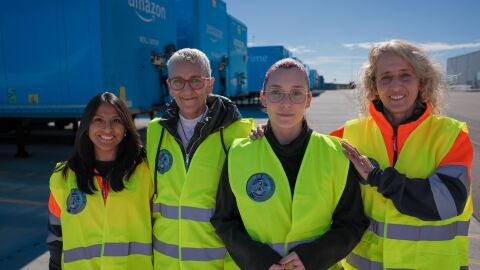Amazon today announced plans to invest more than €1 billion over the next five years to further electrify and decarbonize its transportation network across Europe, delivering packages to customers more sustainably. The investment is also intended to drive innovation across the industry and encourage more public charging infrastructure, which will help enable the broader transportation industry to more quickly reduce emissions.
The company is already using thousands of zero-emission vehicles across its European operations, and this investment will add thousands more, accelerating Amazon’s progress toward becoming net-zero carbon by 2040—10 years ahead of the Paris Agreement.
“Our transportation network is one of the most challenging areas of our business to decarbonize, and to achieve net-zero carbon will require a substantial and sustained investment,” said Andy Jassy, Amazon CEO. “Deploying thousands of electric vans, long-haul trucks, and bikes will help us shift further away from traditional fossil fuels—and hopefully, further encourage transportation and automotive industries in Europe and around the world to continue scaling and innovating, as we will have to work together to reach our climate goals.”
Investment brings more electric delivery vans, e-cargo bikes and on-foot deliveries to cities across Europe
Amazon has more than 3,000 electric vans delivering packages to customers across Europe and, with the investment announced today, expects to grow its fleet to more than 10,000 by 2025.
Amazon has launched micro-mobility hubs in more than 20 cities across Europe, including London, Munich and Paris, and expects to double that figure by the end of 2025. Micro-mobility hubs are smaller, centrally-located delivery stations. In Europe’s traditionally dense cities, the hubs enable Amazon to operate new delivery methods, such as e-cargo bikes and on-foot deliveries, to bring packages to customers more sustainably. Micro-mobility hubs take traditional delivery vans off the road, which alleviates traffic congestion in city centres and improves air quality.
In addition to these new vans and micro-mobility hubs and vehicles, Amazon will also invest in thousands of chargers across its European facilities. The investment will allow the company and its partners to improve fleet charging hardware.
Amazon scales up fleet of electric heavy goods vehicles and expands critical infrastructure to decarbonize long haul trucking
Long haul transportation is a hard-to-decarbonize sector due to the size and weight of the trucks and trailers, and the long distances they need to travel. Electric heavy goods vehicles (eHGVs) are a promising technology, but eHGV production and charging infrastructure availability are limited. Amazon today has five eHGVs on the road in the UK, and will have 20 on the road in Germany by the end of this year.
Amazon is using its size and scale to help spark the scaling of eHGV production so Amazon and others can more quickly transition away from diesel trucks. With the investment announced today, Amazon expects to purchase and roll out more than 1,500 eHGVs in its European fleet in the coming years.
To power its eHGVs, Amazon will build hundreds of specialized fast chargers across its European facilities, allowing the company to charge the vehicles in approximately two hours.
Amazon surpasses 100 renewable energy projects in Europe
Amazon is on a path to powering its operations with 100% renewable energy by 2025, and, in 2021, the company reached 85%. This applies to all Amazon operations such as data centres, logistics facilities, physical stores, and corporate offices, including on-site charging points. Amazon now has more than 100 renewable energy projects across Europe.












